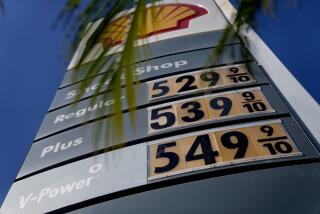A big surprise on gas
Barack Obama thinks the government should intervene on gas prices to “give families some relief,” and last week called for releasing 70 million barrels of crude from the Strategic Petroleum Reserve. John McCain proposes an end to the ban on offshore drilling and has pushed for a gas-tax holiday because “we need it, we need it very badly.”
But both candidates and the public are evidently unaware of a basic fact: Gasoline is more affordable for American families now than it was in the days of the gas-guzzling muscle cars of the early 1960s. Prices are beginning to come down somewhat, but this was true even when the national average was at its summer peak.
Two-thirds of American voters say they think that the price of gas is “an extremely important political issue,” and many believe that it will cause them “serious” financial hardship, according to a recent survey by the Associated Press and Yahoo.
Although it’s true that the real (inflation-adjusted) and nominal (posted) prices of gasoline are higher than at any time since World War II, even at the recent peak national average of $4.11 a gallon (California’s average Friday was $4.17), gasoline is still more affordable today than it was during the Kennedy administration. Federal Reserve Chairman Ben Bernanke worries that increasing fuel prices might eat up so much disposable income that it flat-lines consumer spending and tanks the economy. But it’s difficult to square that worry with what we call the “affordability index” -- the ratio of the average person’s disposable income to the price of gasoline.
After studying the average yearly price of gasoline from 1949 to 2007, and assigning the number “1” to the ratio in 1960, we found today’s prices comparable to what they were in 1960 (1.35 today to 1.00 in 1960, with a high of 3.32 in 1998). The higher the gasoline affordability index figure, the lower the price of gasoline relative to disposable income.
Consumer anger about rising fuel prices has taken a while to build because, until the last year or so, the increases could be shrugged off as natural year-to-year price variation. Moreover, pump prices still seemed relatively cheap given increases in personal wealth. Personal disposable income since 2000, for instance, has increased by an average of about $4,800 a person. Those very real increases in economic well-being reduced the pain of higher prices at the pump. People didn’t notice that real gas prices were higher because the percentage of their income going to the gas station was at an all-time low until recently.
The bad news for politicians is that motorists are noticing now. We are bombarded with reminders, from nightly newscasts to front pages, that gas is more expensive now than it was in the late 1990s. Ask Americans the price of milk, bottled water or orange juice and many won’t have a clue. But virtually every American of driving age sees the large signs proclaiming the price of gas at street corners every day, and has watched the dial on the gas pump tick up to $40, then $60 or higher as they fill their tanks. The bill is high, and it is drilled into our heads.
But perception is not reality where gas prices are concerned. By June of this year, disposable income had risen by an average of $1,627 per person over last year’s figures, according to the Department of Commerce, while the average person’s real expenditures on gasoline increased by about $490. Our incomes are still outpacing gasoline price increases. The problem is that our incomes aren’t outpacing the increase in gas prices lumped together with increases in everything else -- air conditioning, food, etc. Our homes, meanwhile, are losing value.
But gasoline is more affordable than it was during the early 1960s, an era fondly remembered by many as halcyon days of cheap fuel and gas-guzzling American cars. We’re overlooking that context because it’s easier to remember 1998, when we saw the lowest inflation-adjusted gasoline prices in recorded history.
Politicians would do well to remember these historical facts, as well as consumer psychology, when discussing gas prices with voters. Failure to do both will likely result in a government eager to score political points with the electorate by doing exactly the wrong thing.
Indur Goklany is the author of “The Improving State of the World: Why We’re Living Longer, Healthier, More Comfortable Lives on a Cleaner Planet.” Jerry Taylor is a senior fellow at the Cato Institute.
More to Read
Sign up for Essential California
The most important California stories and recommendations in your inbox every morning.
You may occasionally receive promotional content from the Los Angeles Times.










